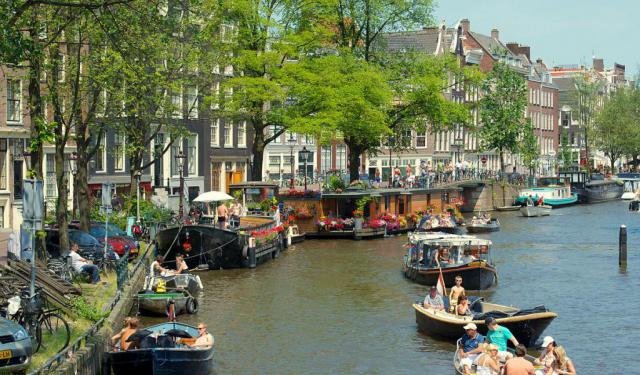
12 Traditional Dutch Foods You Must Try in Amsterdam
Cool climate, closeness to sea, and sense of adventure have made the Dutch what they are – skillful farmers, industrious seafarers and, generally, people with the taste for life and good hearty meal, whether it comes from the sea they live by or the land they set their feet on. All of this has found reflection in the traditional Dutch cuisine. And what is the best place to find it all and have a taste of other than Amsterdam, the crossroads of all things Dutch and not only. The top dozen distinctly Dutch foods appear as follows...
(To visit the venues mentioned in this article, check out these Self-Guided Walking Tours in Amsterdam)
1. Stamppot
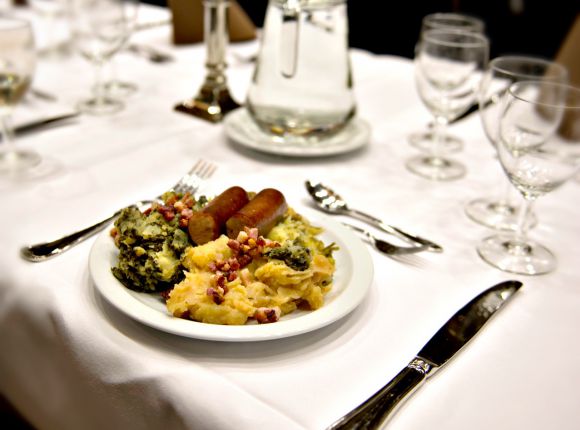
Image Courtesy of: Ministerie van Buitenlandse Zaken
On a cold winter afternoon, after hours of trotting the streets of Amsterdam, you will die for a plate of Stamppot, if you know what that is, of course. Those who haven't had the pleasure yet, will surely be delighted to make acquaintance of this good old Dutch fare of mashed potatoes combined with kale, carrots, endive or sauerkraut. Depending on which vegetable goes in, the name of the dish varies from boerenkool (kale) to zuurkool (sauerkraut) to hutspot (onions and carrots) to andrauweandijvie (endive).
Another inseparable ingridient is ‘rookworst’, the locally made smoked sausage, which makes Stamppot an absolute killer... of hunger during long winter months. There are several eateries in Amsterdam that have it on their menu, including one small restaurant chain called “Stamppotje” that specializes in this specific dish and only during winter months. As it gets warmer, they switch to ice cream. So, if you want to try their Stamppot, make sure to pick the right season.
Another inseparable ingridient is ‘rookworst’, the locally made smoked sausage, which makes Stamppot an absolute killer... of hunger during long winter months. There are several eateries in Amsterdam that have it on their menu, including one small restaurant chain called “Stamppotje” that specializes in this specific dish and only during winter months. As it gets warmer, they switch to ice cream. So, if you want to try their Stamppot, make sure to pick the right season.
2. Erwtensoep

Image Courtesy of: Takeaway
Natives of some European countries East of Holland would probably disagree with the Dutch referring to a pea soup as their traditional dish. In Holland, it goes by the name Erwtensoep (“air-ten-soup”) and its day-old variety is called "snert". No wonder several nations across Europe have shared liking for this simple yet stomach-filling dish, typically thick with split peas, chopped vegetables (onion, leek, celeriac, carrot, potato), and pork (ribs, trotters, and/or bacon).
Perhaps, the distinctly Dutch part of it is sliced rookworst, the local smoked sausage, but then again – who knows what the Germans or Poles call their sausages accompanying this soup. Indeed, who cares! To a hungry stomach, Erwtensoep feels like an epitome of self-sufficient farmship in the Dutch countryside. Just make sure they serve it to you complete with roggebrood, a dense rye bread, and that will see you through another cold winter day in Amsterdam.
Perhaps, the distinctly Dutch part of it is sliced rookworst, the local smoked sausage, but then again – who knows what the Germans or Poles call their sausages accompanying this soup. Indeed, who cares! To a hungry stomach, Erwtensoep feels like an epitome of self-sufficient farmship in the Dutch countryside. Just make sure they serve it to you complete with roggebrood, a dense rye bread, and that will see you through another cold winter day in Amsterdam.
3. Bitterballen
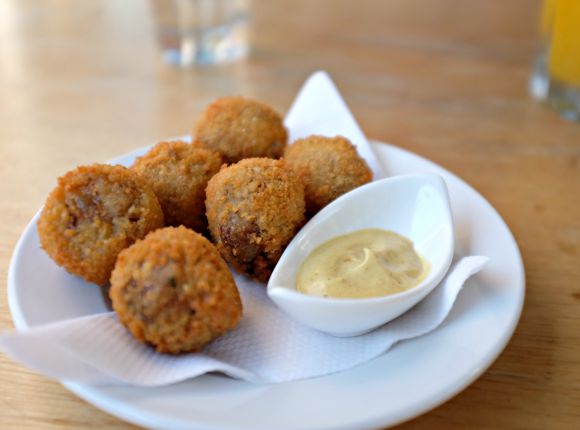
Image Courtesy of: Min Zhou
Meatballs aren't novelty to most European cuisines, but, seemingly, only the Dutch have had the imagination to make meatballs – ‘Bitterballen,’ as they call it – a beer snack. Pursuant to the Dutch love of beer, you can find these in most any regular café or bar in Amsterdam. For extra crunchiness, the balls of meat are deep fried in oil and dressed in breadcrumb coating. Juicy and soft on the inside, Bitterballen are traditionally served with mustard. Care with the first bite!
The inside filling – a ragout-like mixture of beef, beef broth, butter, flour and spices – can be extremely hot. Lovers of ‘kroketten’ will find these very much alike in terms of stuffing, cooking, and flavor. Just be careful with the pronounciation when ordering Bitterballen in a restaurant, so as not to say "Dieter Bohlen" (German singer, member of the Modern Talking duo so popular in the 80s) instead...)))
The inside filling – a ragout-like mixture of beef, beef broth, butter, flour and spices – can be extremely hot. Lovers of ‘kroketten’ will find these very much alike in terms of stuffing, cooking, and flavor. Just be careful with the pronounciation when ordering Bitterballen in a restaurant, so as not to say "Dieter Bohlen" (German singer, member of the Modern Talking duo so popular in the 80s) instead...)))
4. Herring
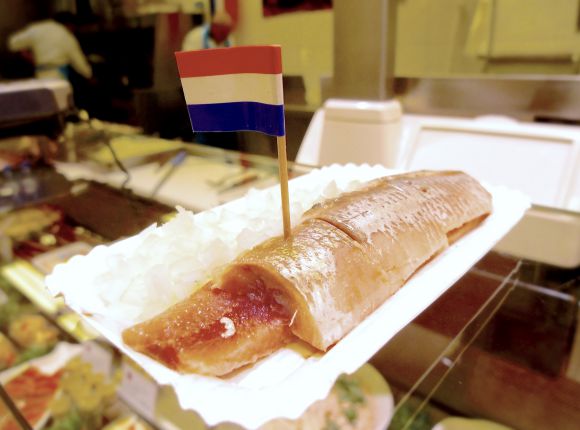
Image Courtesy of: Franklin Heijnen
Just as any other North (and Baltic) Sea fishing nation, the Dutch are passionate about herring – fatty, oily fish, full of flavor and omega-3 vitamines. You can hear tales of sea-hardened men, back in the old days, eating whole raw herrings on the streets of Amsterdam, of which tale-like is only the “raw” part (the fish were slightly brined).
Herring fishing has been inseparable part of the Amsterdam history from its very beginning, largely responsible, together with the beer trade, for its fast-growing wealth, especially after the Dutch came up with the idea of curing the fish, thoroughly gutted beforehand, to make it last longer. The herring season commences in May, and it is then that all the excitement over "nieuwe haring" (the Hollandse for “new herring”, symbolyzing the first catch of the season) traditionally begins.
However, these days, sanitary regulations demand that all herring caught in the sea be frozen (so as to kill the worms inside) and, thus, good fish is available all year long (knowledgeable people say, in fact, that herring in November tastes just as good as it does in June). This, in turn, has given rise to numerous haringhuis (herring stands) and vishandels (fish shops) throughout the city. The Dutch take their herring lightly cured in salt, with a bit of onion and, traditionally, a shot of schnapps.
Herring fishing has been inseparable part of the Amsterdam history from its very beginning, largely responsible, together with the beer trade, for its fast-growing wealth, especially after the Dutch came up with the idea of curing the fish, thoroughly gutted beforehand, to make it last longer. The herring season commences in May, and it is then that all the excitement over "nieuwe haring" (the Hollandse for “new herring”, symbolyzing the first catch of the season) traditionally begins.
However, these days, sanitary regulations demand that all herring caught in the sea be frozen (so as to kill the worms inside) and, thus, good fish is available all year long (knowledgeable people say, in fact, that herring in November tastes just as good as it does in June). This, in turn, has given rise to numerous haringhuis (herring stands) and vishandels (fish shops) throughout the city. The Dutch take their herring lightly cured in salt, with a bit of onion and, traditionally, a shot of schnapps.
5. Patat (or Vlaamse Frites)
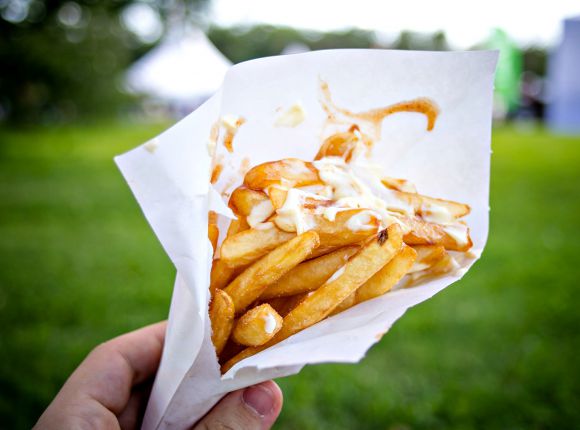.jpg)
Image Courtesy of: Kurt Bauschardt
Just as Belgians next door, the Dutch are keen on fried potato sticks, be it fries, chips, frites or whatever else you might wish to call it. They themselves call it patat, or Vlaamse frites (“Flemish fries”) to emphasize the North Belgian origin. Crunchy as French fries, and thick-cut as British chips, this originally Flemish patat is a popular street snack in Amsterdam and is sold here in large quantities all over the place – from small storefront counters to street stands to fast-food joints, you name it. Usually, they come wrapped up in paper cones and generously topped up with a sauce. The latter is either standard mayonnaise (yfritessaus) or some lethal Dutch combo called oorlog (“war”); alternatively, they drown them in a mix of mayo, peanut satay sauce, and raw onions. Wonder what the famous Pulp Fiction characters, Jules Winnfield and Vincent Vega, might have to say on the subject...???
6. Kaas (Dutch Cheese)
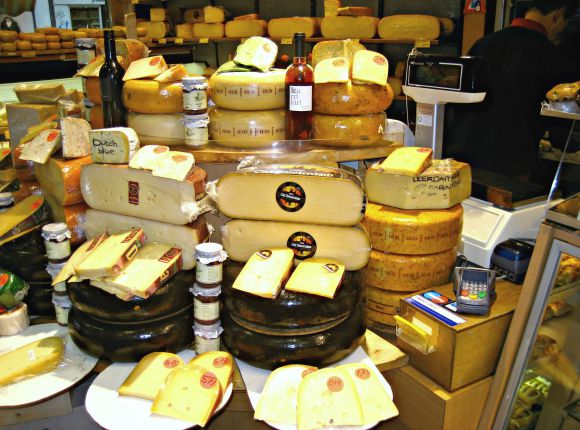.jpg)
Image Courtesy of: Alistair
Those cheese-conscious of you, who have the luck to try authentic Dutch cheese for the first time, might honestly believe that the term "kaas" (Dutch for "cheese") is just the slightly crippled English "class" which somehow lost its "L" over time, but nonetheless fully describes the palette of feelings running through one's brain, inspired by the taste of this, perhaps, one of the most famous Dutch delicacies.
In Holland, they've been making cheese since 800 B.C., which is probably what puts the country among the world's elite cheese makers and exporters. Statistically, an average Dutch person consumes annually 21 kilos of kaas in vivid illustration of the love they have for their production. Dutch cheeses are predominantly made semi-hard or hard, but there are many other types available as well.
The most popular of them are ‘Gouda’ and ‘Edam’; when in Amsterdam, look out for ‘Old Amsterdam’! The Dutch have it for breakfast, put on sandwiches for lunch or just grab as a casual snack (cut in cubes) dipped into mustard. It goes equally well with a glass of wine or beer. One of the places in Amsterdam where you can put this to a test is Reypenaer’s Tasting Room.
In Holland, they've been making cheese since 800 B.C., which is probably what puts the country among the world's elite cheese makers and exporters. Statistically, an average Dutch person consumes annually 21 kilos of kaas in vivid illustration of the love they have for their production. Dutch cheeses are predominantly made semi-hard or hard, but there are many other types available as well.
The most popular of them are ‘Gouda’ and ‘Edam’; when in Amsterdam, look out for ‘Old Amsterdam’! The Dutch have it for breakfast, put on sandwiches for lunch or just grab as a casual snack (cut in cubes) dipped into mustard. It goes equally well with a glass of wine or beer. One of the places in Amsterdam where you can put this to a test is Reypenaer’s Tasting Room.
7. Hagelslag
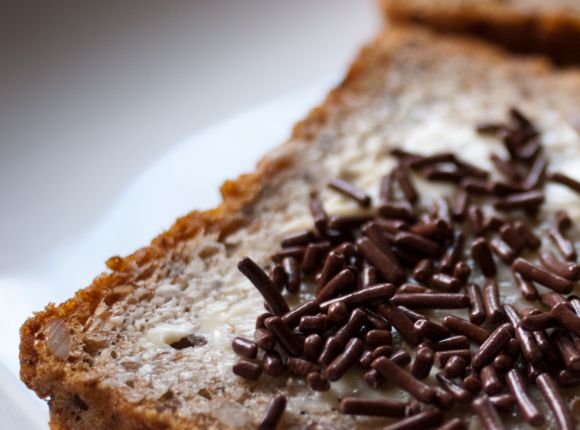
Image Courtesy of: Nathan Siemers
The Dutch kids and grown-ups alike love sprinkles on their food. They even have a special term, ‘Hagelslag’, for sprinkle sandwich filling which works for both, breakfast and lunch sandwiches. The Dutch passion, however, doesn't stop at sandwiches and you will find them sprinkle many other things as well, mostly desserts. ‘Chocolade hagelslag’ (chocolate sprinkles) are top of the list here. Following closely are alternate varieties such as anise (licorice) seed ‘hagelslag’ and fruit flavored ‘hagelslag’.
8. Rijsttafel
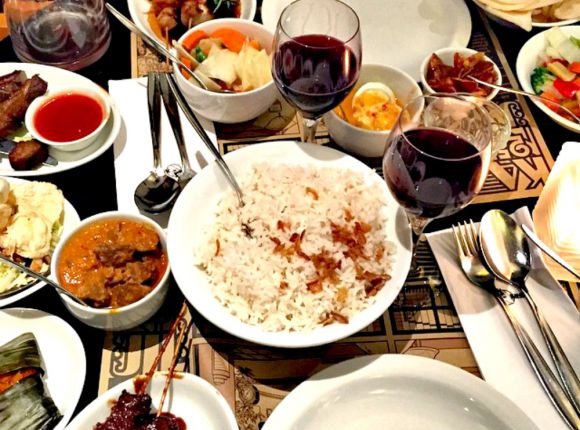
Image Courtesy of: Jonas Nordström
Rijsttafel [ryst-tah-fell] (“rice table”) is a culinary spin-off from the three hundred years of Dutch colonization of Indonesia, for a long time manifested in the form of the Dutch East India Company, ended in 1949. Upon their return home, the Dutch brought along a newly-acquired passion for satay (spicy peanut) sauce, a bunch of Indonesian stir-fry recipies, and a habit of serving many small dishes all at once, centered around rice, which vividly demonstrated and allowed to appreciate in one go the richness of Indonisian cuisine. In large part, rijsttafel was also influenced by the Dutch liking of Sumatran manner of feasting, known as nasi padang.
Today's rijsttafel maintains the old tradition and sees every inch of the table packed to the maximum, sometimes with up to 40 little dishes—various meats, vegetables, and spices, such as sambals and pickled dishes—set to accompany the centerpiece of steamed white rice. Curiously enough, this manner of serving has grown so deeply into the Dutch tradition that, nowadays, they treat it as almost their own, like stamppot or something, which, in turn, largely adds exotic hues to Amsterdam’s culinary picture.
Today's rijsttafel maintains the old tradition and sees every inch of the table packed to the maximum, sometimes with up to 40 little dishes—various meats, vegetables, and spices, such as sambals and pickled dishes—set to accompany the centerpiece of steamed white rice. Curiously enough, this manner of serving has grown so deeply into the Dutch tradition that, nowadays, they treat it as almost their own, like stamppot or something, which, in turn, largely adds exotic hues to Amsterdam’s culinary picture.
9. Stroopwafel
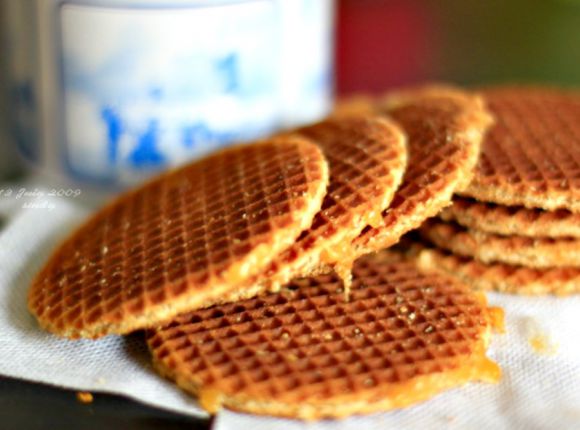
Image Courtesy of: sⓘndy°
If it wasn't for ‘stroopwafel,’ not sure what else could have just as successfully secured a place for The Netherlands in the pantheon of the world's major pastry powers. Luckily, the cookie has done its job well, rendering Holland renowned around the globe for this horizontally sliced waffle made from baked batter. The stroopwafel formula involves two thin layers of waffle stuck with a special syrup (called ‘stroop’) in between. The stiff batter for waffles' recipe includes butter, flour, yeast, milk, brown sugar and eggs.
The home spot of ‘stroopwafel’ is Gouda, a place south of Amsterdam. The snack orininated there around the late 18th-early 19th centuries, courtesy of some unknown baker who used leftovers from his baking business (breadcrumbs, etc.) and had them sweetened with syrup. A stroke of genius! (well, almost, if he had the wits to copyright the invention for the posterity to collect royalties...))) ‘Stroopwafels’ are available at all major supermarkets in Amsterdam.
The home spot of ‘stroopwafel’ is Gouda, a place south of Amsterdam. The snack orininated there around the late 18th-early 19th centuries, courtesy of some unknown baker who used leftovers from his baking business (breadcrumbs, etc.) and had them sweetened with syrup. A stroke of genius! (well, almost, if he had the wits to copyright the invention for the posterity to collect royalties...))) ‘Stroopwafels’ are available at all major supermarkets in Amsterdam.
10. Appeltaart
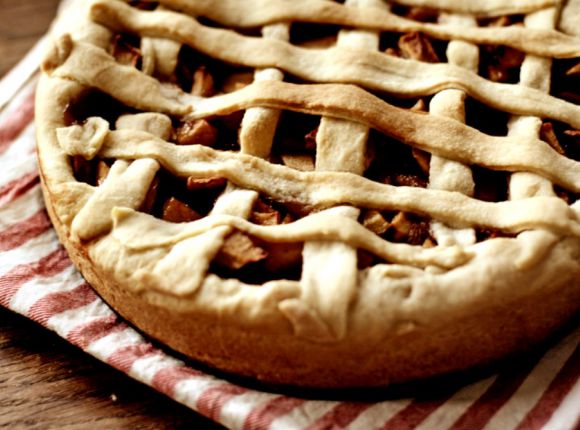
Image Courtesy of: Suzette - www.suzette.nu
An apple pie could be "ten a penny" these days, but back in 1514, when the Dutch first printed a cookbook featuring appelltaart recipe, it wasn't! Unlike the neighboring France, where they leave apple tarts open, in Holland they make appeltaart deep and covered with pastry on both ends (top and bottom). Inside goes a mixture of apple slices or pieces (goudreinet is the most commonly used apple sort for that), sugar, cinnamon and lemon juice. On some occasions, raisins or currants could be added as well. Traditionally, the top part of the pie is adorned with lovely lattice made of pastry strips, through which one can see the inner stuffing. The habitual companions of appelltaart are met slagroom (whipped cream) and koffie (coffee, a cup of).
11. Ossenworst
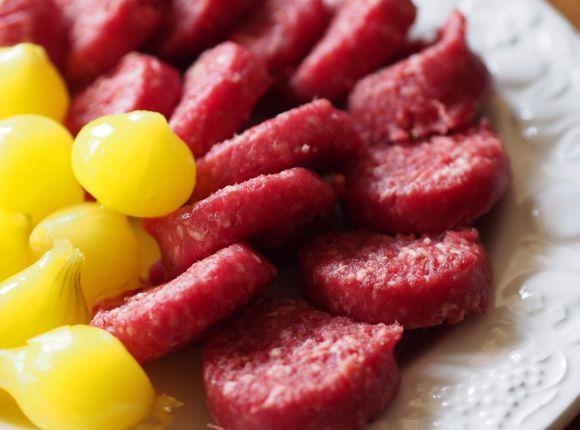
Image Courtesy of: Takeaway
Back in the 17th century, parts of oxen were largely in use by culinars across Europe, hence the appearance of oxtail soup (originally from Flanders) and ossenworst ("oxen sausage", emerged on the Amsterdam food scene courtesy of the kosher tradition brought in by Jewish immigrants).
Originally made of oxen, today's ossenworst contains beef and condiments — salt, pepper, cloves, nutmeg, and mace — enclosed in beef casing and very lightly smoked so as to appear almost raw when eaten. Similarly to steak tartare, it has a soft, gentle flavor, but its texture may not be a straightforward hit with many (requires some getting used to). Still, those who do manage past the first round, will find it an excellent match for beer, cheese, and bread sandwiches (broodjes).
Originally made of oxen, today's ossenworst contains beef and condiments — salt, pepper, cloves, nutmeg, and mace — enclosed in beef casing and very lightly smoked so as to appear almost raw when eaten. Similarly to steak tartare, it has a soft, gentle flavor, but its texture may not be a straightforward hit with many (requires some getting used to). Still, those who do manage past the first round, will find it an excellent match for beer, cheese, and bread sandwiches (broodjes).
12. Drop (or Liquorice)
.jpg)
Image Courtesy of: Dr_Kelly
The Dutch confidently lead the world in terms of liquorice consumption, devouring annually some 32,000 tonnes. The magnitude of passion for this type of sweets in Holland approaches the level of addiction; they seem prepared to eat these liquorice drops till they drop. The key element in its production is a root extract from liquorice plant. The candies are available both, sweet and salty, and come with various flavours and in a broad range of shapes. You won't have to look hard to buy liquorice in Holland, as they are sold almost everywhere. If you're a liquorice lover, chances are that you were Dutch in your previous life...
Get GPSmyCity App for IOS or Android
You can read offline thousands of travel articles like this one in the "GPSmyCity: Walks in 1K+ Cities" app on Apple App Store or Google Play Store. The apps also offer city offline maps and GPS navigation to guide you to the places featured in the articles.
Walking Tours in Amsterdam, Netherlands
Create Your Own Walk in Amsterdam
Creating your own self-guided walk in Amsterdam is easy and fun. Choose the city attractions that you want to see and a walk route map will be created just for you. You can even set your hotel as the start point of the walk.
Jordaan Walking Tour
The Jordaan district of Amsterdam is a popular neighborhood renowned for its charming, narrow streets, quaint courtyards, and picturesque canals. Replete with beautiful historic houses, many of which have been converted into cozy cafés, trendy boutiques, and art galleries, this district has a distinctive atmosphere that sets it apart from other areas in the city.
The Jordaan was originally... view more
Tour Duration: 1 Hour(s)
Travel Distance: 2.4 Km or 1.5 Miles
The Jordaan was originally... view more
Tour Duration: 1 Hour(s)
Travel Distance: 2.4 Km or 1.5 Miles
Southern Canal Belt Walking Tour
The Canal District, known as Grachtengordel in Dutch, is a globally renowned example of urban planning and architectural excellence within Amsterdam. This area has remained remarkably well-preserved for over four centuries, celebrated for its charming small bridges, canal crossings, and 17th-century residences. Encircling the Old City Centre in a horseshoe shape, the Canal Ring encompasses three... view more
Tour Duration: 2 Hour(s)
Travel Distance: 3.1 Km or 1.9 Miles
Tour Duration: 2 Hour(s)
Travel Distance: 3.1 Km or 1.9 Miles
Amsterdam Food Tour
Amsterdam's food scene is a delightful fusion of local traditions and global influences. Making your way through the interlocking canals, pretty bridges, and a maze of streets laden with diverse eateries and bars may easily render you hankering for a bite to eat and/or a drink to wash it down with.
The diverse culinary landscape of Amsterdam caters to a wide range of tastes and... view more
Tour Duration: 2 Hour(s)
Travel Distance: 2.6 Km or 1.6 Miles
The diverse culinary landscape of Amsterdam caters to a wide range of tastes and... view more
Tour Duration: 2 Hour(s)
Travel Distance: 2.6 Km or 1.6 Miles













